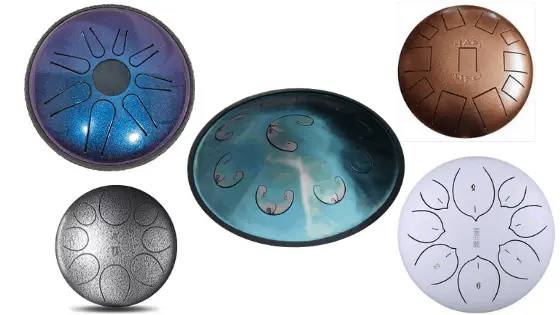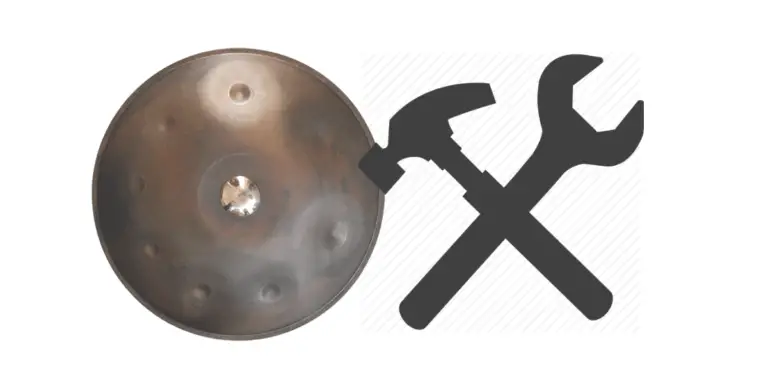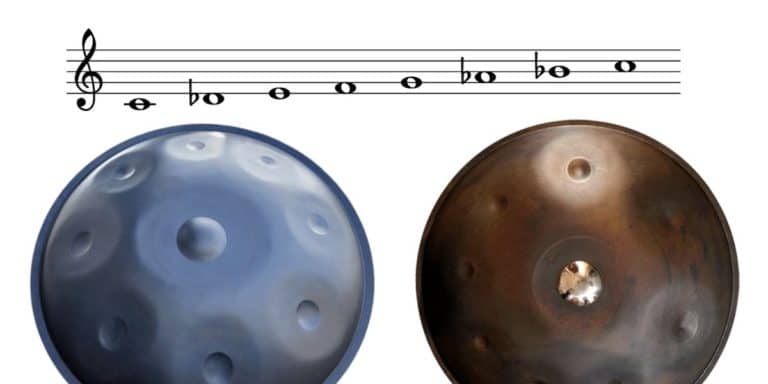Steel Tongue Drum vs Handpan – A Comparison
It’s not a war, just a comparison between the handpan instrument and the similar but at the same time very different steel tongue drum.
Finding this article, you may have zero knowledge of what either instrument, is does, or can do, and want to know more, or perhaps you already know a little and want to find more details of the distinctions between these two fabulous instruments.
Range of Choice
Something you may discover early on is with handpans, they are pretty much standard in terms of design at first glance. Similarly designed, sized and weighted, they are mostly made from very similar materials
The main noticeable difference between handpans is not even the scale from a visual point of view but the number of notes. Whilst most handpans will have between 7-10 notes arranged on the top, variety comes in additional tone fields (up to around 21) placed both on top and bottom halves of the instrument.
Tongue drums by contrast come is a huge array of sizes, tongue tone fields shapes, colors, designs and more
Handpan vs Tongue Drum Prices
One of the first differences between a handpan and steel tongue drum you will notice is the cost of owning one.
Tongue drums, even the very best are considerably cheaper than good handpans.
Handpans are not cheap, in fact, one of the most commonly asked questions is regarding the cost of a handpan. Many people do not expect the answer they get when asking ‘How much does a handpan cost?‘
| Type | Products | Price |
| HP | High Quality [to order] | $2500 |
| HP | RavPan (handpan) | $1900 |
| HP | Reasonable Quality [off Shelf] | $1000+ |
| TD | Rav Vast Tongue Drum | $700+ |
| TD | Helios Double Sided | $700+ |
| TD | Kindred Spirit Range | $350+ |
| TD | Guda Freezbee | $350 |
| TD | Idiopan Tunable Tongue Drum | $229 |
There are some handpans around that will rival the tongue drum price (Sub $1000), but the advice is to stay as far away as possible.
These are inferior quality instruments that will deteriorate very quickly and probably will be out of tune and untunable at the point of receiving them if not shortly after. – YOU HAVE BEEN WARNED!
How Long to Wait for a Handpan vs Tongue Drum?
Is there really a waiting time when buying handpans and tongue drums?
If you want something specific then the chances are you may have to wait on the handpan side. The range of tongue drums available, as already discussed, will mean that unless you are after a very specific Rav Vast Tongue Pan, the likelihood is that you will be able to purchase immediately off the shelf.
Waiting Time Comparison
| Instrument | Waiting Time |
| Bespoke Handpan | up to 6 months |
| Standard Handpan | Mostly Instant |
| Bespoke Rav Vast | 1-2 Months |
| ‘in-Stock’ Rav Vast | Instant |
| Most Other Tongue Drums | Instant |
Things are improving in terms of waiting times for handpans. there was a time when a 2-year wait for your instrument would not have been sniffed at.
Things have improved somewhat since those days, although I currently have one on order which I expect to wait a full 5 months to receive at best. There are many options where bespoke orders can be turned around much quicker, and with far more producers making handpans these days, there is often some off the shelf options, if you are prepared to pay for shipping.
Size
Most handpans are around about the same size up to around 20 inches in diameter. This is dictated by the necessity of a certain surface area to be able to fit the tone fields required to suit the scales. The top section can have anything between 7 and 12 notes, whilst there is also the bottom half that contains the Gu hole and more space for notes if required.
By contrast, the tongue drum can come in a variety of sizes, from just a mere 5.5 inches in diameter to around 12 inches wide. Size is not always determined by the number of tongues on the drum but plainly the smaller versions have a limitation to the number that be included.
Tone Fields
This is where handpans and tongue drums differ in another very noticeable way. The tone field or the notes that you play will look completely different. The handpan containing dimples, with no piercing of the steel, whereas the steel tongue drum tongues will be cut into the steel, in a variety of shapes, but as the name suggests, many are tongue-shaped.
Dimples and a Ding
The general set up of a handpan is a single Ding, or Apex dimple on the top of the handpan, surround by inpex dimples which make up the remainder of the tone fields. Each is crafted perfectly to create the pitch required within the scale chosen for the handpan.
These are set in so much as once created, they are not tunable of changeable by the player. Unless they have super handpan crafting skills.
Under no circumstance should anyone who does not know how to tune a handpan attempt to retune, or adjust the tuning of their handpan. It is almost certain you will cause hundreds of dollars worth of damage and pay the price when taking it to an expert to correct
For more information on tuning take a look at this handpan tuning guide.
Tongues
Tongue drums have slits cut into the steel, mostly on the top side. These cuts are very visible, and they create a range of sizes, which in turn with a little adjustment and weighting turn into the notes you play when struck.
In most cases, as with the handpan, you will find tongues only on the top of the instrument, in some cases, you will find tongue drums that also have tongues on the bottom too. Double-sided tongue drums are different from handpans with top and bottom notes in that they contain a different scale on each side, depending on which way up you play.
Another difference to handpans is that tongues are not a uniform shape, like the dimples on a handpan. They can, and do, come in a range of shapes. Rav vast is distinctive with the ‘V’ cut into each, there are oblong tongues, more rounded tongues and more.
And another difference with tongues is that there are some manufacturers who produce Tunable Tongue drums. The pitch of each tongue is set with the positioning of a super-strong magnet on the back of the tongue, which when moved will affect the pitch. Each magnet can be repositioned to adjust these pitches so that you can create a new scale to play. It takes a little practice but isn’t too hard once you get used to it.
You will be limited to a certain number of scales in this way, but additional magnet packs [different sizes], can be purchased to extend the scale options further. This is a huge benefit and difference to handpans which once tuned are set to that scale.
Weight
Given the general difference in size there will be a noticeable difference in weight also. Handpans tend to be larger and therefore heavier.
| Instrument | Weight |
| Handpans | 7-10lbs |
| Tongue Drums | 2-10lbs |
| Rav Vast | 10.8lbs |
| Rav Vast 2 | 13lbs |
The RAV Vast is about 4.9kg, and the Vast 2 is about 5.9kg. The reason for the difference in weight is not dimensions on the Rav vast 2 but the thicker steel used in production.
How much does a handpan weigh?
Handpans weigh between 7lbs-10lbs. There is little difference between the great majority of handpans, as regardless of maker, they mainly come in roughly the same dimensions and very similar materials
How much does a steel tongue drum weigh?
Steel Tongue drums can be as light as 2lbs up to 10lbs in weight. This is determined by both the size of the instrument and the materials used in manufacturing. The Rav Vast range, are either 10.8lbs or 13lbs in weight
Tuning/Scales
The choice of scales available on both handpans and tongues drums is almost endless.
I have a couple of articles around Scales, both on how to choose the scale of your handpan, and also a reference library of scales which is under constant construction
The Difference in Volume Between Handpan and Tongue Drum
This is a question I hear over and over again. And you know, my normal answer is ‘Why does it matter?’ – They are different instruments and the range of different togue drum styles and sizes means there is no straight answer. On occasion, people mistake volume for resonance which can also differ from instrument to instrument.
Rav Vast have a definitive answer on their website
the RAV Vast is about 15% quieter than a handpan, but sounds warmer. Where as the RAV Vast2 is the same loudness as a handpan.
Rav Vast Website FAQ section
Playing Style
Some may claim that the way of playing a handpan is very different to playing a tongue drum, with the exception of the use of mallets I wouldn’t really agree. you can play both with hands, using various areas, fingers, thumbs, knuckle and palms on both [depending on the size of tongue drum)
Learning the playing style and technique on handpan or tongue drum can be tricky. This instrument is not a drum, and should not be struck like one in terms of trying to achieve volume. It is not a Djembe, or Bongo, the flat of the hand is not going to produce great sound, and more delicate but definite strikes with the fingers and thumbs will produce the beautiful sounds.
Hands or mallets?
From a personal point of view, I would say no to mallets on a handpan. Unless you know exactly what you are doing, and know your handpan and it’s limitations inside and out, mallets, for me, are a no-no. It would be quite easy to damage your handpan over time using mallets, especially is used incorrectly. If you want to play steel with a stick, grab a steel drum, or a tongue drum.
Tongue drums are far more suited to mallet percussion play. The tone field are stronger, and in some cases, especially in the smaller instruments, easier to pay with small mallets – Don’t go buying Marimba Mallets!!
Stands
Most often you will not have use for, or indeed be able to find a stand for a tongue drum, They are designed to be played either in the lap, and most have rubber feet so they can be placed atop a table or counter and played that way.
The handpan can also be played in the lap, will not have rubber feet, and does have a number of options for stand use. Stands are available for both sitting and standing positions for playing, and there are some that are adjustable to account for both styles.
I have a full guide to handpan stands on-site, highlighting my favorite options across a range of quality including value, looks, and versatility. There is even a DIY handpan stand option there if you want to have a go at making your own.
Climate
Now, you didn’t think I was going to talk about the climate in this tongue drum vs handpan comparison piece, did you?
Whilst I would not recommend against any place on the planet being suitable for either instrument [not that you would find me anywhere especially cold], the climate is a consideration for each.
Extreme heat and direct sunlight is a definite thing to avoid for handpans. It can and will soften the steel, and whilst hot damage can be done. So keep it out of the sun and if it is affected, remove and leave in a cool dark place before playing again.
These instruments are made of steel, so humidity can be an issue as well as salt if you are near the coast. Steel will rust. Nitrided steel is believed to be more susceptible to rusting too, so keep all these things in mind.
Also, take into consideration when buying tongue drums, that super cheap instruments are not going to be as hard-wearing in these circumstances and super quality products. There is more surface area for an attack on tongue drums thanks to the slits made in the steel and therefore more areas that can be affected.
There are products that can be used to help in this case and take a look at my best oil for handpans article for more information
Handpans vs Tongue Drum Summary
I am a huge fan of both handpans, tongue drums and the Rav Vast. The latter, for some reason, I always pull out as a separate. Not sure If I am right or wrong in doing that, but in my mind, they are just different enough to standard tongue drums for me to do so.
Do I have a preference?
Yes, I do. I do prefer the handpan as an instrument, it was the first I came across and have connected with on a spiritual level more, but I do really enjoy the different experiences of the tongue drum and especially the RAV which is growing on me more and more each day.
Do I have a recommendation for you as to which to buy?
No, It is up to you. I would advise doing just about as much research as you can on each instrument, watch hours of YouTube videos to see which you connect with best, enjoy the sound and think you would like to learn more.
I have tried to add as much information as I could on this website, gained through my own personal journey of discovery and development, it is only my opinion and experience but hope the information can help you decide which way you would like to go.







